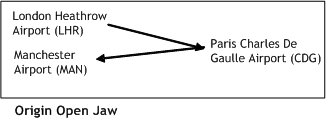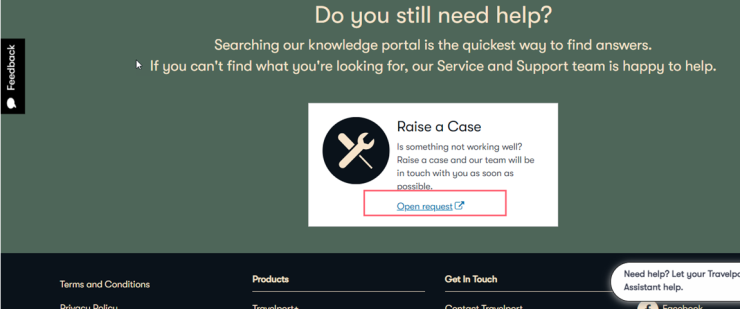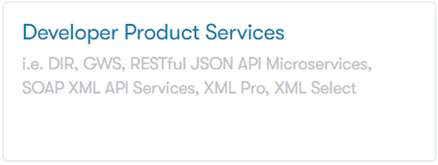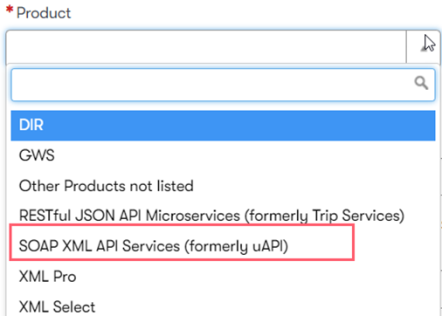There are several types of simple and complex itineraries that can be booked using Universal API.
Important! Some suppliers may not support a specific type of itinerary. For example, many ACH suppliers support only One-Way or Round-Trip itineraries.
Simple Itineraries
There are three types of simple itineraries:
-
One-way (OW)
You are flying from somewhere (your origin) to somewhere else (your destination). -
Return or Round trip (RT)
You are flying from your origin to your destination (which for return fares is also called the point of turnaround) then back to your origin. Notice that for complex routings what you consider your destination might not be what the airline considers your point of turnaround, which is used primarily for fare calculations. -
Open jaw (OJ)
Your travel includes a surface sector (traveled other than by air) either at the origin or the turnaround of the journey. See Open Jaws and Surfaces for details.
Notes:
-
See Structured Fare Rules Definitions for Open Jaw Stopovers, Return or Round Trip, One Way, and other categories.
-
See ARNK (Arrivel Unknown) for Open Jaw trip that results in a mismatch between a destination airport and the origin airport of the following segment.
Routings
When flying from your origin to your destination, there are two options:
-
Non-stop flights flying directly without any touchdown between origin and destination.
-
Flights that touch down.
It is the last option that generates a lot of complications with fares. When you land en route, the stop can take the following forms:
-
Intermediate stop/technical stop
The plane touches down to take on fuel, off-load passengers, or on-load passengers, then you continue your journey on the same plane with the same flight number. -
Change of equipment/change of gauge
Your flight touches down and you change to a different airplane. However, the flight number stays the same throughout your journey. Notice that a change of equipment with the same flight number still counts as a direct flight according to IATA rules. -
Online transfer
You change from one flight to another flight operated by the same carrier. -
Interline transfer
You change from one flight operated by one carrier to a flight operated by another carrier.
For example, in the routing EDI-BM/M-LHR-QF/Y-SIN-QF/Y-SYD:
-
You are flying from Edinburgh (EDI) on a British Midland flight (BM) in M class.
-
You are flying to London Heathrow (LHR) where you have an interline transfer to a Qantas (QF) flight in Y class and continue to Singapore (SIN).
-
In Singapore you have an online transfer to another Qantas flight in Y class, continuing on to Sydney (SYD). I
-
In between your flight from London to Singapore, you have an intermediate stop in Bangkok (BKK), but as it is not considered a transfer, this stop does not necessarily display in the routing.
The routing may show only the points traveled and omit the carrier/class designation (e.g., EDI-LHR-SIN-SYD).
Transits and Stopovers
If your plane touches down and you transfer to another plane (either online or interline), you have two options:
-
Transit
When you continue your journey as soon as possible, normally on the first scheduled flight onwards, but at least within 24 hours. In Central America, the rule is within 6 hours rather than 24 hours, and in North America it is within 4 hours. -
Stopover
When you stay more than 24 hours. With a stopover, you can fly from London to Sydney, but spend a few days en route in Singapore. Stopovers provide a whole different set of fare rules. In North America, stopovers are any time spent that is more than 4 hours.Note: Stopover vs. Layover
-
A layover is a broad term that means any connection between flights, including a stop as short as 30 minutes, depending on the airport, or as long as four hours.
-
Layover can also mean up to 23 hours and 59 minutes on international flights.
-
Typically, it is acceptable to use the term layover when you really mean 'connection.'
-
-
A stopover can be a layover, but it can also be a much longer stop.
-
Often, a stopover is a second destination on part of a multi-stop, or multi-leg itinerary.
-
If traveling in North America, a stopover typically qualifies as anything that lasts longer than four hours.
-
-
A transit normally displays in the routing with a lower case x (e.g., LHR-xSIN-SYD or LHR-(x)SIN-SYD).
Open Jaw and Surface Trips
In the Simple Travel section, a return trip was described as flying from your origin to your destination and back to your origin; your destination could also be referred to as your point of turnaround. There is another type of travel called Open Jaw (OJ) in which you return to a different airport than where you originated, or you leave from a different airport than where you arrived. This type of travel is called Open Jaw because your air routing looks like an open mouth (from the side) if you draw the routing on a map.
Note: There is no need to specify the fare type for an Open Jaw, as automated pricing of the itinerary prices the correct fare type.
For example, when routing an open jaw journey, you are flying from London Heathrow (LHR) to Paris (CDG) and then flying from Paris to Manchester (MAN). Your air routing is:
|
Outbound: LHR-CDG Inbound: CDG-MAN |
|
In the example above, the open jaw occurs at the origin, which is called an Origin Open jaw (OOJ). An open jaw at your destination is called a turnaround open jaw/destination open jaw (TOJ)
The following example is an open jaw that occurs at the destination. For example, you are traveling from London Heathrow to Sydney, Australia (SYD). You decide to take a train from Sydney to Brisbane and then return to London. The train trip from Sydney to Brisbane is referred to as a surface sector, which is any part of your journey in which the mode of travel is not flying. Surface sector travel can include non-flight options such as ship or boat. Your routing is:
|
Outbound: LHR-SIN-SYD Inbound: BNE-SIN-LHR |
|
When you have an open jaw at either the origin or destination, you have a Single Open Jaw (SOJ). If you have an open jaw at both the origin and destination, you have a Double Open Jaw (DOJ).
|
Outbound: LHR-SIN-SYD Inbound: BNE-SIN-MAN |
|
Note: See also:
-
Structured Fare Rules for Open Jaw
-
ARNK (Arrivel Unknown) for an Open Jaw trip that results in a mismatch between a destination airport and the origin airport of the following segment.
Complex Travel
A special form of return trip is a Circle Trip (CT). A circle trip is a return trip that usually includes multiple stops along the route of travel before returning to the point of origin. For example, London to Australia via Asia on the way out and Australia to London via the United States on way back.
A Round The World (RTW) fare is a fare with no destination or, where the origin and the destination are the same. You are traveling around the world and as long as you are within the rules of your ticket, the RTW fare applies. The RTW fare specifies a number of details, including how many times you can stop and how many miles you can fly.





